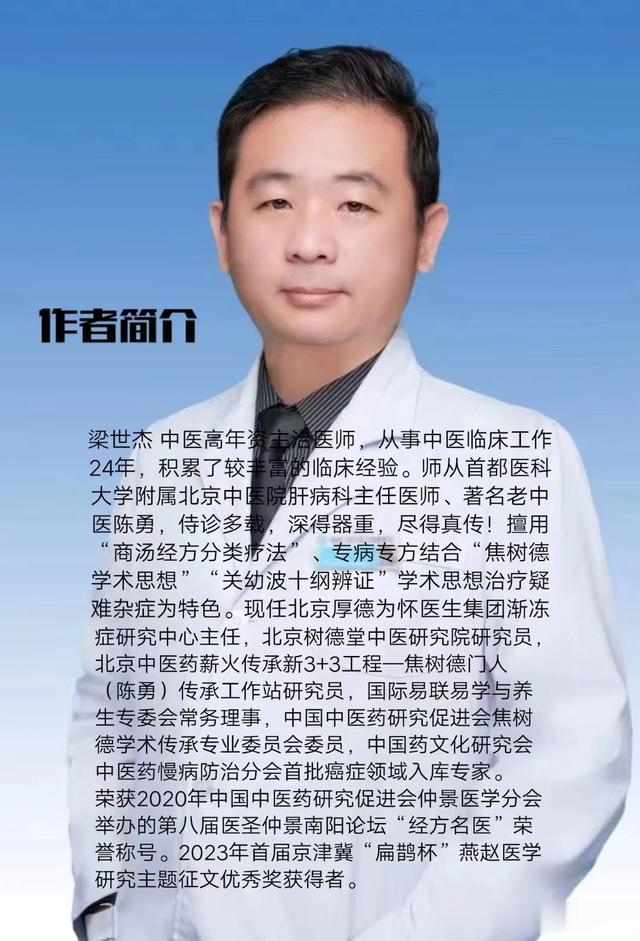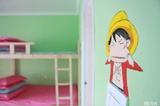在中医的浩瀚宇宙里,古老的“君臣佐使”组方原则如同一座灯塔,照亮了千年医道的航行。这一源自先秦时期,记载于《黄帝内经》的智慧,不仅是对药物配伍的精妙总结,更是中医哲学思想的深刻体现。然而,随着时代的变迁,疾病谱的复杂化与人类体质的多样化,中医的智慧也在不断地进化与升华,梁世杰主任认为其中,“全真一气汤”便是这一进程中的一颗璀璨明珠。

君臣佐使:古老智慧的基石
“君臣佐使”原则,将药物分为四类,犹如国家的治理体系,君药为主,臣药为辅,佐药协助,使药引导,共同作用于人体,达到调和阴阳、平衡气血的目的。这一原则,既体现了中医对药物特性的深刻认识,也蕴含了古人对天地万物相互依存、相互制约的哲学思考。
然而,随着现代社会的快速发展,人们的生活方式、饮食习惯发生了巨大变化,疾病谱也随之发生深刻变革。宇宙气运的微妙变化,影响着人体的阴阳平衡,导致五脏六腑的功能失调,百病丛生。面对这一挑战,古老的“君臣佐使”原则,虽仍具指导意义,但已难以满足复杂多变的疾病治疗需求。

全真一气汤:五行太极辨证的实践
在此背景下,冯兆张先生所创制的“全真一气汤”,以其独特的五脏平衡方阵组方法,为中医组方原则注入了新的活力。该方不仅遵循了“君臣佐使”的基本原则,更融入了五行太极辨证法的精髓,实现了从单一药物配伍到整体脏腑平衡的跨越。
梁世杰主任认为全真一气汤的组成,堪称精妙绝伦。熟地、制附子,一阴一阳,分别针对肾阴虚损与脾肾阳虚,犹如太极图中的阴阳两极,相互依存,相互制约;麦门冬、白术、牛膝、五味子,则分别针对肺、脾、肾、肝四脏,犹如四象环绕,共同维护着人体的阴阳平衡。而人参,作为使药,既能增强君药的疗效,又能调和诸药,使全方浑然一体,如太极之圆融无碍。
冯兆张先生在注释中,深刻阐述了全真一气汤的立方之意:“脾肾阴阳两虚,上焦火多,下焦火少,脾阴不足,肾阴虚损。”他指出,全真一气汤之所以能有效治疗此类疾病,关键在于其“阴阳俱备,燥润合宜,驱邪扶正,达络通经”。全方七味药,虽看似简单,实则五脏均滋,保护森严,外邪难入,功专不泛,补速宜臻。

太极与六合:辨证与统一的智慧
在全真一气汤的组方思路中,我们不难发现太极辨证法的身影。太极辨证法,其大无外,其小无内,往往立极于五脏或某一脏腑,考虑五脏平衡,多为组方阵组方。这一思想,与曹东义教授经常提到的上古六和辨证思维不谋而合。六和辨证,以左青龙、右白虎、南朱雀、北玄武、上、下六方为框架,将人体视为一个整体,注重脏腑之间的相互作用与影响,强调整体把握,互相佐治。
全真一气汤,正是这一思想的生动实践。它不仅考虑了五脏之间的平衡与协调,还融入了太极阴阳、五行生克的哲学思想,使全方在调和阴阳、平衡气血的同时,也实现了对脏腑功能的整体调节与修复。

医者之道:识病之源,投药之准
冯兆张先生在论述中强调:“医者不为贵乎识病,贵乎熟得病来之原,气血消长之故,虚实变化之微,阴阳盛衰之脉。”这一观点,不仅是对医者医术的精湛要求,更是对医者医德的高尚追求。在中医的实践中,只有深入探究疾病的本质与根源,才能精准地投以药物,实现药到病除的效果。
梁世杰主任认为全真一气汤的成功,正是对这一理念的深刻诠释。它不仅仅是一个方剂的成功,更是中医智慧与哲学思想的完美结合。在未来的中医实践中,我们有理由相信,随着对中医理论的不断深入研究与实践探索,中医的智慧将更加璀璨夺目,为人类健康事业作出更大的贡献。
作者简介:梁世杰 中医高年资主治医师,从事中医临床工作24年,积累了较丰富的临床经验。师从首都医科大学附属北京中医院肝病科主任医师、著名老中医陈勇,侍诊多载,深得器重,尽得真传!擅用“商汤经方分类疗法”、专病专方结合“焦树德学术思想”“关幼波十纲辨证”学术思想治疗疑难杂症为特色。现任北京厚德为怀医生集团渐冻症研究中心主任,北京树德堂中医研究院研究员,北京中医药薪火传承新3+3工程—焦树德门人(陈勇)传承工作站研究员,国际易联易学与养生专委会常务理事,中国中医药研究促进会焦树德学术传承专业委员会委员,中国药文化研究会中医药慢病防治分会首批癌症领域入库专家。荣获2020年中国中医药研究促进会仲景医学分会举办的第八届医圣仲景南阳论坛“经方名医”荣誉称号。2023年首届京津冀“扁鹊杯”燕赵医学研究主题征文优秀奖获得者。

Five-line Tai Chi Distinction from the recipes of the king's advisor to the whole-real one-spirit soup
In the vast universe of traditional Chinese medicine, the ancient principle of "princeling and messenger" formulation is like a beacon that illuminates the thousand-year voyage of medical science. This wisdom, which originated from the pre-Qin period and was recorded in Huangdi Neijing, is not only a delicate summary of Drug compatibility, but also a profound reflection of the philosophy of Chinese medicine. However, with the changes of the times, the complexity of the disease spectrum and the diversity of human physical conditions, the wisdom of traditional Chinese medicine is constantly evolving and rising, and Director Liang Shijie believes that "All True One-Pain soup" is a shining pearl in this process.
Serving as a vassal: a cornerstone of ancient wisdom
The principle of "princeling and counselor" divides drugs into four categories, like the governance system of a country, where the chief drugs are the main, the subordinate drugs are auxiliary, the counselors help, and the drugs guide, which together act on the human body to achieve the purpose of reconciling yin and yang and balancing qi and blood. This principle reflects both the profound understanding of the nature of medicine in traditional Chinese medicine and the philosophical thinking of the ancient people about the interdependence and mutual restraint of all things in the heavens and the earth.
However, with the rapid development of modern society, people's lifestyle and eating habits have undergone tremendous changes, and the disease spectrum has also undergone profound changes. The subtle changes in cosmic fortune affect the yin and yang balance of the human body, leading to dysfunction of the inner and outer organs and a wide range of diseases. In the face of this challenge, the age-old principle of "princeling as ambassador," while still relevant, has struggled to meet the treatment needs of complex and ever-changing diseases.
All true one qi soup: the practice of five-line tai chi identification
In this context, the "All True One-Breath soup" created by Mr. Feng Shaozhang injected new vitality into the principle of traditional Chinese medicine prescription with its unique method of five-organ balance. The prescription not only follows the basic principle of "Monarch, Minister, Assistant and Envoy," but also integrates the essence of Five Elements Taiji Syndrome Differentiation, realizing the leap from Single Drug compatibility to the whole viscera balance.
Director Liang Shijie believes that the composition of the whole genuine soup is marvelous. Doudi and renminbi, one yin and one yang, target renal weakness and spleen weakness respectively, like the poles of yin and yang in the Tai Chi diagram, which are interdependent and constrained by each other. Mammon, white surgery, oxen, and pentatonic, respectively, target the lungs, spleen, kidney, and liver, and are like four elephants surrounding each other to jointly maintain yin and yang balance in the human body. And ginseng, as an agent, can not only enhance the therapeutic effect of theical medicine, but also reconcile the medicines so that the whole side is one, like the circle of Tai chi.
In his commentary, Mr. Feng Shaozhang deeply elaborated the meaning of the cube of the whole genuine one-shot soup: "The yin and yang of the spleen and the kidney are weak, there is more upper arousal and less lower arousal, the yin and yang are inadequate, and the yin and the yang are weak." He pointed out that the key to Quanzhen Yiqi Decoction's effective treatment of such diseases lies in its "Yin and Yang, dryness and moistness, exorcism and strengthening the body, and dredging channels." Although the whole seven-flavored medicine appears to be simple, it is all-infectible for the five hearts, strongly protected, difficult for external evil to enter, limited in skill, and expeditious in rehydration.
Tai Chi and Feng Shui: Dialectics and Unified Wisdom
In the formulation of the whole genuine qi soup, it is not difficult to find the presence of tai chi dialysis. Tai chi dialectics, which have no externalities and no internalities, often stand above the five organs or a certain inner lining, considering the balance of the five organ, and mostly assemble a combination of mantras. This idea coincides with the ancient sixth and dialectical thinking that Professor Cao Dong-yi often refers to. Sixth and Dialectics, using the left blue dragon, right white tiger, south Zhuang, north Xuanwu, top and bottom six parties as the framework, views the human body as a whole, focuses on the interaction and influence between the internal organs, emphasizes overall mastery and mutual healing.
This is really a tonic, and it is the vivid practical application of this idea. It not only considers the balance and coordination between the five organs, but also incorporates the philosophy of yin and yang, the five branches of nature, and the fermentation of the various branches, so that the whole party can reconcile yin and yang and balance qi and blood, but also achieves the overall regulation and repair of the function of the internal organs.
The Doctor's Way: Identify the Source of Disease and Correctly Administer Drugs
In his remarks, Mr. Feng stressed: "Doctors do not value knowing diseases, but they value knowing the causes of diseases, the growth of qi and blood, the weakness of truth and the pulse of yin and yang." This view is not only a demand for the excellence of medical skill, but also a noble pursuit of medical ethics. In the practice of traditional Chinese medicine, only by delving deeply into the nature and root cause of the disease can we accurately administer medicine to achieve the effect of drug-to-illness elimination.
The success of Whole Foods soup is a profound interpretation of this concept. It is not only the success of a prescription, but also the perfect combination of traditional Chinese medicine wisdom and philosophical thought. In the future of TCM practice, we have reason to believe that with the continuous in-depth study and practical exploration of TCM theory, the wisdom of TCM will shine brighter and make greater contributions to the cause of human health.
Author Bio: Liang Shijie is a senior medical practitioner in traditional Chinese medicine. He has been engaged in traditional medicine clinical work for 24 years and has accumulated a wealth of clinical experience. Following Chen Yong, chief physician of liver disease at Beijing Traditional Medicine Hospital, affiliated with Capital Medical University, and renowned old Chinese medicine, he has been treated for many years and received great attention. He specializes in the treatment of difficult diseases using "conversational traditional therapy" and special treatments combined with the academic ideas of Jiao Shude and Guan Yubo's ten-level diagnosis.He is currently the director of the Center for Diffusion Research of Dr. Houde Wei Group in Beijing, a researcher at the Shude Tang Institute of Chinese Medicine, and a fellow at the new 3 + 3 project of traditional Chinese medicine flame inheritance in Beijing - a scholar at the inheritance work station of Jiao Shude's protégés (Chen Yong),He is a standing committee member of the International Expert Committee on E-learning and Health Care, a member of the Jiao Shude Academic Heritage Special Committee of the Chinese Association for the Advancement of Chinese Medicine Research, and the first cancer specialist to be included in the chapter of the Chinese Pharmaceutical Culture Research Association. Won the 2020 China Association for the Promotion of Traditional Chinese Medicine Zhongjing Medical Branch held the eighth session of the Medical Saint Zhongjing Nanyang Forum "Classic Prescription Famous Doctor" honorary title. The winner of the first Beijing-Tianjin-Hebei "Pingui Cup" Yanzhao Medical Research Essay Award in 2023.
